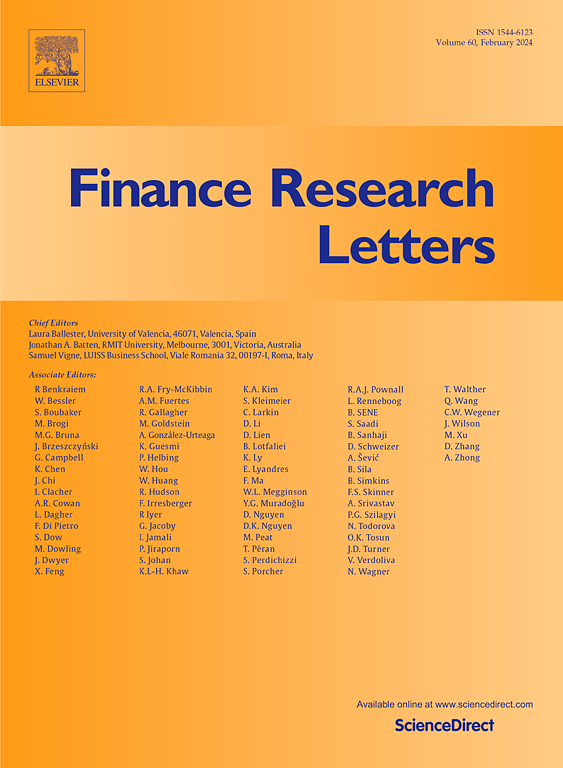竞争文化会影响企业绿色创新泡沫吗?
IF 6.9
2区 经济学
Q1 BUSINESS, FINANCE
引用次数: 0
摘要
本文利用2009-2023年中国a股上市公司的数据,研究了竞争文化、财务错配、管理短视、高管绿色创新和企业绿色创新泡沫之间的相互作用。使用多阶段分析框架,我们进行了具有固定效应的基线回归来建立核心关系,随后进行了中介检验和有调节回归分析。替代估计和子样本分析证实了稳健性,分层相互作用模型探索了异质性。研究结果表明,超竞争文化通过金融错配机制加剧了绿色创新泡沫。管理者的短视显著增强了竞争文化与绿色创新泡沫的互动关系,而管理者的绿色感知则削弱了这种关系。此外,竞争文化对小型企业、无环境处罚企业和污染密集型企业的绿色创新泡沫有更大的正向影响。这些结果强调了三个关键途径。对于政策制定者来说,这项研究要求重新调整反垄断框架,以监控绿色创新。对于企业来说,这项研究强调对高管进行绿色素养培训,以抵消短视压力。对于研究者而言,本研究开创了行为-金融-可持续性联系模型,从而推动了绿色金融理论超越传统的有效市场范式。本文章由计算机程序翻译,如有差异,请以英文原文为准。
Can competitive culture affect corporate green innovation bubbles?
Using data from Chinese A-share listed firms spanning 2009–2023, this study examines the interactions between competitive culture, financial mismatch, managerial myopia, executive green innovation, and corporate green innovation bubbles. Using a multi-stage analytical framework, we conduct baseline regressions with fixed effects to establish core relationships, followed by mediation tests and moderated regression analysis. Alternative estimators and subsample analyses confirm robustness, and stratified interaction models explore heterogeneity. Findings indicate that a hypercompetitive culture intensifies green innovation bubbles via the mechanism of financial mismatch. Managerial myopia significantly enhances the competitive culture–green innovation bubble interaction, while executive green perception weakens this relationship. Furthermore, competitive culture has a greater positive impact on green innovation bubbles in small firms, firms without environmental penalties, and pollution-intensive enterprises. These results emphasize three critical pathways. For policymakers, this study demands recalibrating antitrust frameworks to monitor green innovation. For corporations, this study underscores executive green literacy training to counteract myopic pressures. For researchers, this study pioneers a behavioral–finance–sustainability nexus model, thus advancing green finance theory beyond traditional efficient-market paradigms.
求助全文
通过发布文献求助,成功后即可免费获取论文全文。
去求助
来源期刊

Finance Research Letters
BUSINESS, FINANCE-
CiteScore
11.10
自引率
14.40%
发文量
863
期刊介绍:
Finance Research Letters welcomes submissions across all areas of finance, aiming for rapid publication of significant new findings. The journal particularly encourages papers that provide insight into the replicability of established results, examine the cross-national applicability of previous findings, challenge existing methodologies, or demonstrate methodological contingencies.
Papers are invited in the following areas:
Actuarial studies
Alternative investments
Asset Pricing
Bankruptcy and liquidation
Banks and other Depository Institutions
Behavioral and experimental finance
Bibliometric and Scientometric studies of finance
Capital budgeting and corporate investment
Capital markets and accounting
Capital structure and payout policy
Commodities
Contagion, crises and interdependence
Corporate governance
Credit and fixed income markets and instruments
Derivatives
Emerging markets
Energy Finance and Energy Markets
Financial Econometrics
Financial History
Financial intermediation and money markets
Financial markets and marketplaces
Financial Mathematics and Econophysics
Financial Regulation and Law
Forecasting
Frontier market studies
International Finance
Market efficiency, event studies
Mergers, acquisitions and the market for corporate control
Micro Finance Institutions
Microstructure
Non-bank Financial Institutions
Personal Finance
Portfolio choice and investing
Real estate finance and investing
Risk
SME, Family and Entrepreneurial Finance
 求助内容:
求助内容: 应助结果提醒方式:
应助结果提醒方式:


